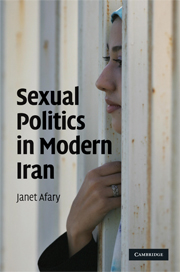Book contents
- Frontmatter
- Contents
- List of illustrations
- Acknowledgments
- Map of Iran
- Introduction
- Part 1 Premodern practices
- Part 2 Toward a Westernized modernity
- Part 3 Forging an Islamist modernity and beyond
- 9 The Islamic Revolution, its sexual economy, and the Left
- 10 Islamist women and the emergence of Islamic feminism
- 11 Birth control, female sexual awakening, and the gay lifestyle
- Conclusion: Toward a new Muslim-Iranian sexuality for the twenty-first century
- Glossary
- Bibliography
- Index
9 - The Islamic Revolution, its sexual economy, and the Left
Published online by Cambridge University Press: 05 June 2014
- Frontmatter
- Contents
- List of illustrations
- Acknowledgments
- Map of Iran
- Introduction
- Part 1 Premodern practices
- Part 2 Toward a Westernized modernity
- Part 3 Forging an Islamist modernity and beyond
- 9 The Islamic Revolution, its sexual economy, and the Left
- 10 Islamist women and the emergence of Islamic feminism
- 11 Birth control, female sexual awakening, and the gay lifestyle
- Conclusion: Toward a new Muslim-Iranian sexuality for the twenty-first century
- Glossary
- Bibliography
- Index
Summary
The 1979 Islamic Revolution was not a wholesale return to the past; rather, the new state reinvented and expanded certain retrogressive gender and cultural practices and presented them as what Foucault has called a “regime of truth” through modern technologies of power. As part of its commitment to modernity, the Islamist state continued the literacy and health campaigns of the Pahlavi era. It also created, alongside the army and the police force, a parallel series of paramilitary forces. Once the regime attained some degree of authority, it established a new juridical discourse on sexuality, with the underlying theme of granting more power over women's sexuality and reproductive functions to the state and to men, while also reversing modern trends in love and marriage. The state encouraged polygamy (multiple ʿaqdi) and temporary marriage, as well as the return of easy divorce for men. While these measures weakened conjugal bonds of affection, they also served to compensate men who had acquiesced to the strictures of the new theocratic state. In the name of morality and the preservation of women's honor, men of all social classes gained easier, cheaper access to sex, both inside and outside of formal marriage. The state reduced the age of marriage, and encouraged motherhood and large families, while limiting or closing other life choices for urban professional women.
- Type
- Chapter
- Information
- Sexual Politics in Modern Iran , pp. 265 - 291Publisher: Cambridge University PressPrint publication year: 2009



